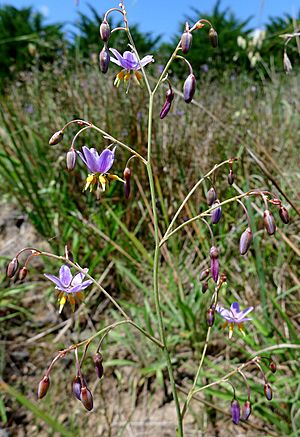Matted flax-lily facts for kids
Quick facts for kids Matted flax-lily |
|
|---|---|
 |
|
| Scientific classification |
The matted flax-lily (scientific name: Dianella amoena) is a special plant found only in Australia. It's a type of plant that lives for many years and has soft, green stems. This plant is considered endangered, which means it's at risk of disappearing forever.
It has long, grey-green leaves that grow in bunches from an underground stem called a rhizome. In spring and summer, it grows beautiful blue-purple flowers. These plants can grow up to 90 centimeters (about 3 feet) tall. The name "matted flax-lily" comes from how its underground stems spread out, sometimes forming large "mats" up to 5 meters (about 16 feet) wide!
Contents
What the Matted Flax-Lily Looks Like
The leaves of the matted flax-lily are thin and grey-green. They are shaped like a "V" when you look at them closely. Sometimes, they even have tiny, peg-like bumps or "teeth" along their edges.
This plant is a "clonal" plant. This means it can make copies of itself without needing seeds. One original plant can create many new plants that are exactly the same, genetically. New shoots can pop up from the underground stems, sometimes as far as 30 centimeters (about a foot) away.
The flowers grow on tall stems, usually 20 to 90 centimeters high. They are very fragrant and have blue-purple petals with bright yellow centers. After the flowers are pollinated by native bees, they turn into dark blue-purple fruits. The plant can flower from October to April if it gets enough water. If it gets too dry in summer, it might lose some leaves, but it usually recovers.
How the Matted Flax-Lily Got Its Name
Dianella amoena was first officially named in 1995 by two scientists, G.W. Carr and P.F. Horsfall. Before that, people knew about it but didn't have a formal name for it.
The second part of its scientific name, amoena, comes from a Latin word meaning "beautiful" or "pleasing." This name was chosen because of the plant's lovely appearance, especially its colorful and fragrant flowers. These flowers are quite large for a plant in the Dianella group.
Scientists have studied the family tree of Dianella plants using their chloroplast DNA and nuclear DNA. This research showed that the matted flax-lily is closely related to other Dianella species like Dianella longifolia, Dianella tarda, Dianella porracea, and Dianella crinoides.
Where the Matted Flax-Lily Lives
The matted flax-lily grows in grasslands and open woodlands. It often prefers areas with volcanic soils. You can find it in scattered places across southeastern Australia. Most of these places are in the states of Victoria and Tasmania. There are also a few records of it in New South Wales.
Sadly, this plant now mostly lives in small patches. These patches are often found along roadsides, railway lines, and in nature reserves within cities. These areas are sometimes not in the best condition. The plant is very long-lived, and new plants don't seem to be growing from seeds very often. Instead, it mostly survives by its underground stems forming new patches.
Protecting the Matted Flax-Lily
The matted flax-lily is listed as "Endangered" under Australia's main environmental law. It's also listed as "Threatened" in Victoria and "Rare" in Tasmania. This means it needs special protection to survive.
The biggest dangers to the matted flax-lily include:
- Weeds: Other plants, especially weeds, can grow over it and take its space and nutrients.
- Habitat disturbance: Things like construction or changes to the land can harm where it lives.
- Mowing and grazing: Being cut down too often or eaten by animals can prevent it from growing.
In 2010, a plan was made to help the matted flax-lily recover. At that time, scientists thought there were about 1,400 plants left in 120 different spots. However, it's hard to count them exactly because of how their underground stems spread. It's difficult to tell if you're looking at one large plant or many separate ones.
Sometimes, these plants are moved to new locations to help them survive or to make way for new buildings. This can also affect the total number of plants.
Uses of Dianella Plants
Some types of Dianella plants have fruits that people can eat. Others are known to be poisonous. Historically, Aboriginal peoples ate the fruits of some Dianella species. They also used the leaves for weaving baskets and other items.
We don't have specific information about the uses of Dianella amoena itself. This is because it was only officially recognized as a unique species in 1995.
Images for kids
See also
 In Spanish: Dianella amoena para niños
In Spanish: Dianella amoena para niños


